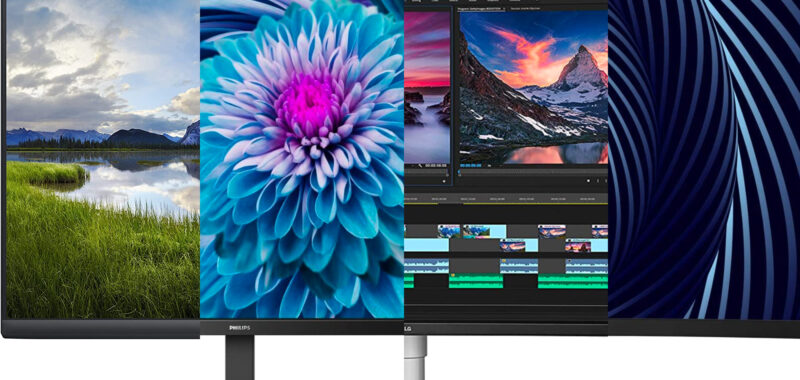We may earn revenue from the products available on this page and participate in affiliate programs. Learn more ›

A solid 4K monitor provides all the screen real estate you need to get things done, whether working from home, gaming, or creating content. A high-resolution display will allow you to see text, photos, and video in great detail—especially recently created media. External monitors have been a common tech accessory for decades, but the marketplace for 4K displays specifically (like our best overall, the Dell S2722QC) has expanded greatly over the past few years. The combination of 4K PC and console games, accessible 4K video, and the necessity of a home office or learning space has accelerated this change. If you’re assembling peripherals for a new computer setup, these are the best 4K monitors available right now.
How we chose the best 4K monitors
The monitor market has recently introduced several new 4K models, but these high-res options aren’t the standard—if you want 4K resolution, that narrows the field right off the bat. And that’s not necessarily a bad thing. Choosing the best one for your needs is easier by eliminating hundreds—if not thousands—of options. From that pool of possibilities, our recommendations are based on meticulous research and careful consideration of the most common uses of a 4K monitor. We’ve also considered the computer platform (Mac or PC) you’re using and whether you’d like to use your monitor with several devices or to replace a TV.
A monitor is the type of tech accessory most people will rely on daily for a decade or more, so our recommendations must stand the test of time and be ready to work with every computer you get. Longevity, multi-functionality, and value were the core virtues we considered when searching for and ultimately selecting the best 4K monitors.
The best 4K monitors: Reviews & Recommendations
Our selection of 4K monitors is designed to match any budget and lifestyle. Some are “all-rounders,” which means they’ll be pretty good for many tasks, while others are designed for a specific purpose—gaming, for example—or have a differentiating tech spec, like a curved panel. Our 4K monitor recommendations will serve you well while browsing the web or streaming video.
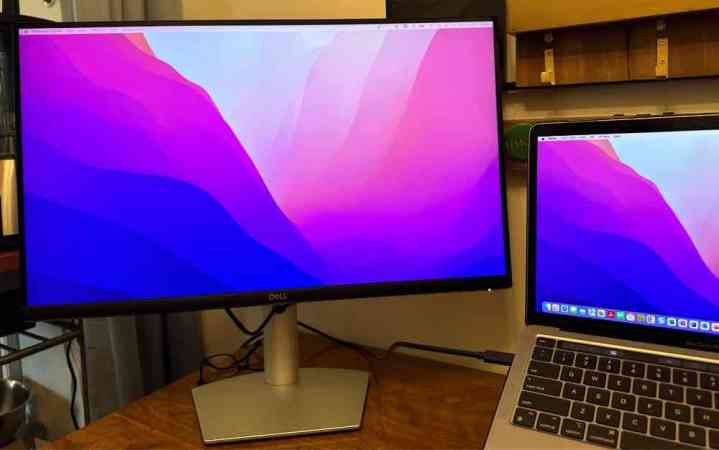
See It
Specs
- Size: 27 inches
- Ports: 1 x USB-C PD, 2 x HDMI, 2 x USB-A, 1 x headphone jack
- Refresh rate: 60Hz
- VESA compatibility: 100 x 100 mm
- Speakers: Yes
Pros
- Can quickly charge laptops while they’re connected
- Multiple USB-A ports
- Built-in speakers
Cons
- Low refresh rate for serious gaming
Dell’s S2722QC is an all-in-one package that offers the right mix of excellent performance for most uses and value. Its most convenient feature for MacBook and modern PC laptop users is a USB-C port, which allows you to connect your computer to it without an adapter. Yes, the S2722QC has multiple HDMI ports, but if you don’t want to deal with thicker HDMI cables, you can hook your laptop up to it with a USB-C cable. This will charge the computer and allow you to connect other accessories to the monitor’s USB-A ports. This configuration turns the 4K monitor into a USB hub. This single-cable solution will make your home office setup look neater, and ensure your laptop is charged when you want to take it out of your home.
We’ve used Dell’s S2722QC hooked up to a 13-inch MacBook Pro via USB-C for several months and have never had an issue with the monitor recognizing the computer or flaking out mid-use. We’ve been especially pleased with the monitor’s color reproduction and overall sharpness when reading text and viewing photos. MacOS automatically puts the monitor in a scaled resolution mode, which admittedly makes text larger and easier to read, but you can switch it to 4K in the “Displays” section of the System Settings app. The monitor performs just as well whether we’ve used it at a scaled or default resolution.
One of this monitor’s most surprising features is integrated 3W speakers. They’re helpful in a pinch, but we still recommend picking up a dedicated set of speakers for your computer if you listen to music frequently. Still, if you’re on a video call and your Bluetooth headphones have run out of juice, it’s helpful to have speakers immediately at the ready. Ergonomically speaking, the S2722QC gets high marks for being height adjustable. The ability to raise and lower the monitor whenever we pleased made working more comfortable as we moved throughout the day.
The S2722QC’s only downside—depending on how you plan on using your 4K display—is its relatively slow 8ms (millisecond) response time and 60Hz panel. This won’t make a difference when you’re watching videos, browsing the web, or editing photos, and we never noticed any perceptible lag in day-to-day use. You’ll only notice this feature when you’re playing fast-paced games like first-person shooters. Casual or slower-paced games don’t require a fast refresh rate display, but cutting-edge titles will suffer slightly, so opt for a dedicated gaming monitor instead.
If you’re not a PC or console gamer looking for a high-resolution display primarily for gaming, the S2722QC will be your best value.
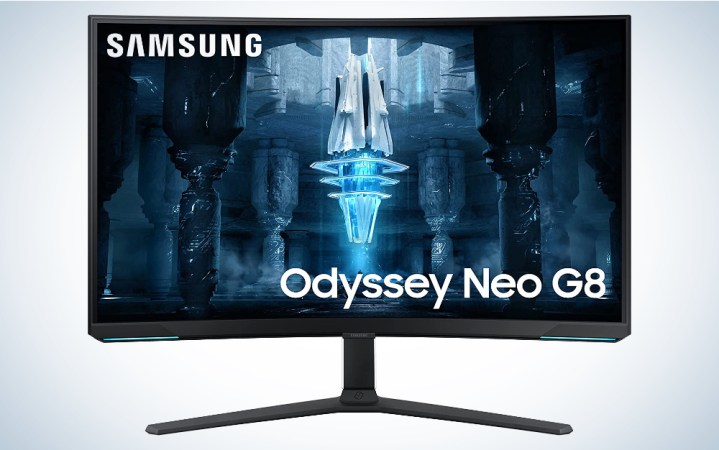
See It
Specs
- Size: 32 inches
- Ports: 2 x HDMI, 2 x USB-A, headphone jack
- Refresh rate: 240Hz
- VESA compatibility: 100 x 100 mm
- Speakers: No
Pros
- Extremely high refresh rate
- Support for Adaptive Sync with AMD and NVidia graphics cards
- Matte display won’t show glare from lights
Cons
- Price
- Curved display may not be for everyone.
If gaming is your primary use case for a 4K monitor, Samsung’s Odyssey Neo G8 is a no-compromise display. Its 240Hz panel is incredibly fast, allowing you to play the latest games at their fastest-possible speed—so long as your gaming computer‘s graphics card and processor are fast enough to handle them. The monitor’s display panel is complemented by built-in software support for Adaptive Sync, which will offer better performance when it’s hooked up to a computer with an AMD or NVidia graphics card.
Adaptive sync will further reduce latency (lag) and the frequency of image artifacts like screen tearing, which can occur when the screen is updated with new images quickly. This technology, which works with settings like low input lag mode and a refresh rate optimizer, increases the probability of smooth, consistent gameplay.
Many modern games support HDR (high dynamic range), which improves contrast and color accuracy when a PC or console is hooked up to a display that supports them. Samsung outfitted the Odyssey Neo G8 with Quantum HDR 2000, so newer games, TV shows, and movies will really pop. Games that don’t support HDR will also look nice, so don’t worry if you spend a lot of time playing the classics.
While Samsung focused primarily on optimizing the Neo G8 for gaming, it made design choices that make it a solid pick for general use. The 4K monitor can be tilted and height adjusted and rotated a full 90 degrees. This is a huge deal ergonomically, as it allows you to position the monitor exactly where you want it without having to get a third-party stand or mount.
The most controversial choice is that the Odyssey Neo G8 has a curved display, a love-it-or-hate-it situation. Curved displays have the advantage of taking up more of your peripheral vision, which, combined with the Odyssey Neo G8’s 21:1 aspect ratio, will create an immersive gaming experience. On the other hand, curved displays can reflect light from multiple angles, which can get frustrating if you’re playing in a well-lit room.
If you have a dedicated PC or console gaming setup, Samsung’s Odyssey Neo G8 can be an excellent 4K desk-friendly display. That said, its cutting-edge hardware does come at an extremely high price. Don’t get us wrong, the Odyssey Neo G8 is an excellent 4K gaming monitor and priced appropriately given its tech specs, but it’s a significant investment.
Game in a darker environment and willing to sacrifice a few pixels for a more immersive viewing experience? You can explore other backlight technologies. Our favorite ultrawide OLED monitor is also in the Samsung Odyssey G8 family.
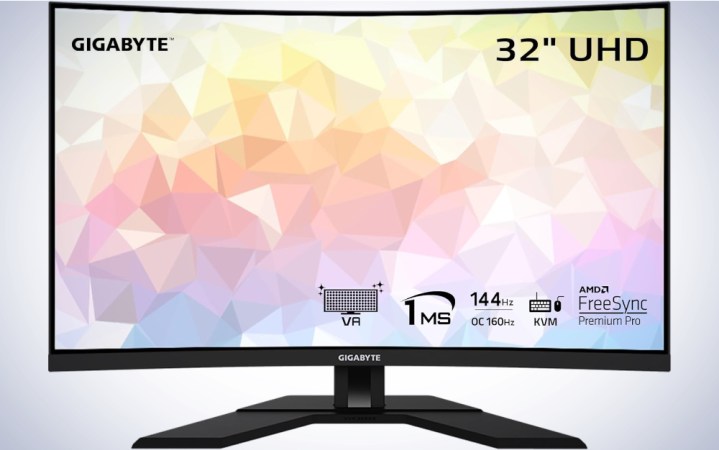
See It
Specs
- Size: 31.5 inches
- Ports: 2 x HDMI 2.1, 1 x DisplayPort 1.4, 1 x USB-C, 4 x USB 3.2 headphone jack
- Refresh rate: 160Hz
- VESA compatibility: 100 x 100 mm
- Speakers: No
Pros
- Large viewing angle
- Fast refresh rate
- Ergonomic design
Cons
- Curved display may not work in rooms with a lot of light
Curved monitors aren’t for everyone, but Gigabyte’s M32UC is our preferred 4K model due to its gamer-forward features and ergonomics. The big reason to get a 4K curved monitor is to have a display that covers more of your peripheral vision, which can be helpful if you get distracted while working. However, curved displays will catch and reflect light from more angles, so you should seriously consider the light source in your room before picking one up, as a constant bright blotch on your screen can also be distracting. If you already know the risks associated with curved monitors and want a high-resolution model, there’s a lot to like about the M32UC.
Serious video and photo editors will appreciate that the M32UC covers 93% of the DCI-P3 color gamut, 123% of the sRGB color gamut, and supports DisplayHDR 400. It’s paramount that the display you’re using is as accurate as possible, and this monitor will deliver for prosumers. Similarly, gamers who want a truly immersive high-resolution PC gaming experience will take advantage of the M32UC’s HDR (High Dynamic Range) support along with its 160Hz refresh rate. Modern games will move fluidly on this display—provided your PC has enough graphical hardware to run the latest titles at such a high resolution and frame rate simultaneously.
Every type of user will benefit from the M32UC’s height-adjustable stand—especially helpful if you’re using the monitor in a room where the sun is at risk of reflecting off its display throughout the day. You’ll also appreciate the monitor’s port selection, which includes multiple USB-A and HDMI ports in addition to a USB-C and DisplayPort. It’s easy to connect several peripherals, computers, and game consoles to the M32UC at the same time without using a single adapter.
If you’re comfortable using a curved monitor and want a 4K display as your digital canvas, GIGABYTE’s M32UC is our top pick.
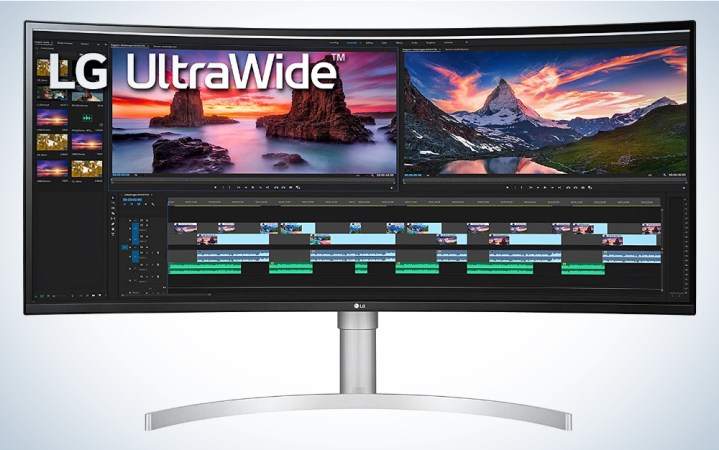
See It
Specs
- Size: 38 inches
- Ports: 1 x Thunderbolt (USB-C), 2 x HDMI, 1 x DisplayPort, 2 x USB-A, 1 x Headphone jack
- Refresh rate: 144Hz
- VESA compatibility: 100 x 100 mm
- Speakers: No
Pros
- Massive display that’s still VESA-compatible
- Solid refresh rate for gaming
- Wide port selection
Cons
- Price
- May be too big for many desks
Ultrawide monitors have become popular recently because they allow you to have two full-sized windows open on a single display rather than requiring a dual-monitor setup. At 38 inches wide, the 38WN95C-W requires a huge space commitment, but you’re rewarded with a curved display guaranteed to take up all of your peripheral vision. Technically, this is a QHD+ (3840 x 1600) display, which isn’t quite a “true 4K,” but it’s the closest you’ll get with a display like this. The monitor would have to be comically tall to accommodate the extra 500 pixels, and you won’t miss them with this type of display.
The 38WN95C-W is stacked on the tech side, especially in its port selection. You can connect four devices to it simultaneously using its mix of HDMI, DisplayPort, and Thunderbolt ports. The monitor’s Thunderbolt 4 input—the same shape as a USB-C port—has the same benefits as the one in our best overall pick for this guide. You can charge your laptop and connect it to accessories through the 38WN95C-W’s pair of USB-A ports with a single cable.
Gamers will appreciate the 38WN95C-W’s 1ms response time, 144Hz refresh rate, and support for AMD FreeSync and NVidia G-Sync, all of which make this monitor a solid pick for 4K gaming. The difference between a 4K 120Hz monitor and one that runs at 144Hz is noticeable when playing games that require precise movement. Its height, swivel, and tilt-adjustable stand also score points in the ergonomics arena. Frankly, it’s hard to find a task the 38WN95C-W isn’t well suited for.
The limiting factor for this display is space—if you have enough and are committed to living the ultrawide monitor lifestyle, the 38WN95C-W can handle anything you throw at it with aplomb.
Best for video editing: BenQ PhotoVue SW272U

See It
Specs
- Size: 27 inches
- Ports: 1 x USB-C, 2 x HDMI 2.0, 1 x DisplayPort 1.4, 1 x USB-B, 2 x USB-B, 1 x SD Card slot, 1 x Headphone Jack
- Refresh rate: 60Hz
- VESA compatibility: 100 x 100 mm
- Speakers: No
Pros
- Support for 100% sRGB, 99% Adobe RGB, 99% DCI-P3 color spectrums
- Video and photo-centric built-in features
- Height-adjustable stand
Cons
BenQ’s PhotoVue SW272U is the best monitor we’ve ever tested for video editing, and professionals in this field should take notice. The 4K display is calibrated and tested for color accuracy before leaving its factory for Delta E ≤1.5 accuracy. BenQ includes a certification report with the display so you can be sure it passed the inspection. The display covers 99 percent of DCI-P3 color gamut, is Calman-verified and Pantone-validated, and offers 10-bit support for 1.07 billion colors. This level of performance allows you to use the SW272U for professional video editing work right out of the box.
Additional video and photo editing-centric settings include a P3 color preview to ensure accurate colors before you deliver a video to clients and Paper Color Sync, which allows you to fine-tune color settings without burning through precious photo paper and ink. These features aren’t necessary for folks who need a 4K monitor for common uses but are essential for creative professionals whose work needs to be as polished as possible. The included Hotkey Puck G3 makes it easy to change settings with shortcuts, saving you time throughout the day.
If you’re working in an environment with a lot of natural light, the SW272U has you covered. We tested this monitor in a room with south and west-facing windows and have no issues seeing the screen, thanks to the 400 nits of brightness. In terms of ergonomics and build, this IPS monitor features an anti-glare coating, essentially eliminating reflections, making it more comfortable to look at for multiple hours in a row. It has a sturdy stand with plenty of adjustment options and a leatherette base. The SW272U doesn’t have built-in speakers, but its headphone jack allows you to plug headphones in if you’re mixing audio for a key scene.
It’s expensive, but BenQ’s PhotoVue S272U offers truly outstanding quality, a robust feature set, and excellent ergonomics for long editing sessions—making it the best splurge for creatives.
Best portable: SideTrak Solo 4K
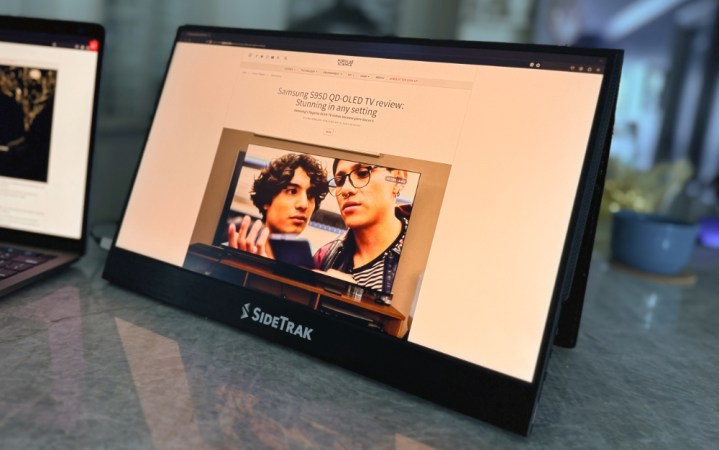
See It
Specs
- Size: 15.6 inches
- Ports: 2 x USB-C, 1 x USB-A, 1 x Mini HDMI
- Refresh rate: 60Hz
- VESA compatibility: N/A
- Speakers: Yes
Pros
- Can be powered by a single cable
- Thin enough to pack in a backpack
- Improves the ability to multitask out of the house.
Cons
SideTrak’s Solo 4K is far and away the most technically impressive portable monitor we’ve tested and a must-have for creatives who need as many pixels as possible when working from outside their home. The 15.6-inch 4K display weighs under three pounds and is under half an inch thick, which allowed us to take it around in a backpack during our tests without feeling over-encumbered.
We used the Solo 4K with a 13-inch MacBook Pro and connected the two using a single USB-C cable (included), which provided power and transferred data. Our computer immediately recognized the 4K display, configured it appropriately, and never lost its connection. MacOS put the Solo 4K into a scaled resolution mode by default, and it worked well whether we used this stock setting or adjusted it to its native 4K monitor resolution. SideTrak also configured the Solo 4K’s picture preset appropriately, so we didn’t have to touch that to get colors that looked accurate instead of washed out or overexposed.
If you’re used to working on two high-resolution displays at home, it’s incredible how much more efficient you can be when taking a similar setup on the road. We found ourselves using the Solo 4K as a separate pane dedicated to tasks like photo editing and keeping our e-mail and work chat apps open while using our laptop’s built-in display for writing posts. Having additional information available at a glance rather than having to break focus by switching to a different piece of software was immediately beneficial.
Multitasking became possible when working at a coffee shop—be sure to snag a table with enough space for both a laptop and monitor side-by-side—in ways that wouldn’t have been practical otherwise. Frequent travelers who find themselves at a disadvantage while working in transit or at their temporary destination will find their roadblocks eliminated. The only technical fault we could find with the SideTrak Solo 4K was its fairly weak speakers, which is understandable when you consider the thinness of this display. If you need a 4K display that can be reasonably taken anywhere, SideTrak’s Solo 4K is the solution.
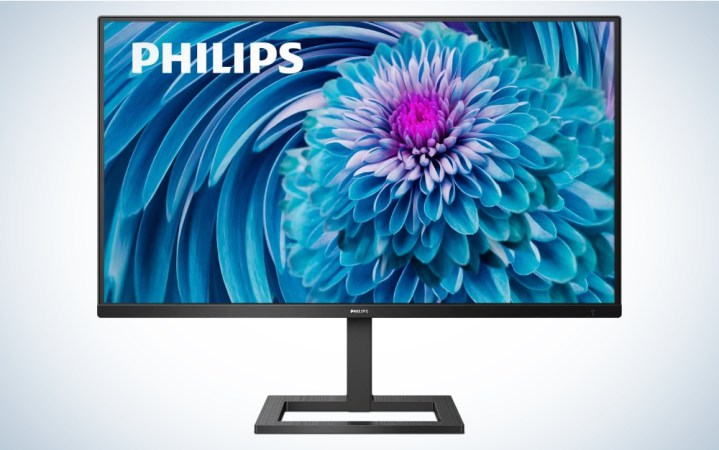
See It
Specs
- Size: 28 inches
- Ports: 2 x HDMI, 1 x DisplayPort, 1 x Headphone jack
- Refresh rate: 60Hz
- VESA compatibility: 100 x 100 mm
- Speakers: Yes
Pros
- Support for 120 percent of the sRGB spectrum
- Height and tilt adjustment
- Price
Cons
- Refresh too slow for gaming
Philips’ 288E2E proves how far the affordability of 4K monitor technology has come in a relatively short time. For $270 (at the time of this reporting), you’re getting a 28-inch 4K display with AMD FreeSync support, the ability to display 120 percent of the sRGB color spectrum, built-in speakers, and an ultra-slim design. Philips had to make very few feature cuts when designing this display, and they mostly come down to nice-to-have-but-unnecessary extras, namely a USB-A port and ultra-fast refresh rate.
These commissions aren’t glaring—though gaming on a 60Hz panel isn’t ideal—and make the 288E2E feel like a slightly more barebones version of our best overall pick, Dell’s excellent S2722QC. Part of this 4K monitor’s appeal is its averageness. Hear us out: There’s no curved panel or ultrawide design, just a straight-ahead high-resolution display. While this may be relatively boring, it’s exactly what most people are looking for in a 4K monitor for general tasks. This display even has built-in speakers, a relative niche feature not found in many of its competitors in this price range.
If your needs are relatively modest, the difference between Philips’ 288E2E and other picks is insignificant. You can use the money you save by picking up this display to upgrade additional parts of your home office setup.
What to consider when buying the best 4K monitors
Several factors should be considered when deciding which 4K monitor fits your needs. These are the five we’ve deemed most important when conducting our research to help you make your selection:
Screen size
4K monitors come in a variety of sizes, but bigger doesn’t always necessarily mean better. A large monitor will take up more room on your desk and may not be necessary if your needs are modest. Photo and video editors can take full advantage of the space available on a 38-inch 4K monitor more easily than a writer or typical student. Ironically, it’s easier to see individual pixels on a monitor as its screen size grows, which may annoy you if you’ve got very sharp sight. The 4K monitors we recommend run the gamut from 27-38 inches.
Ports
A monitor’s ports (also called inputs) determine which cable is required to connect it to a computer or other tech accessory. All 4K monitors above are equipped with multiple HDMI ports, the most common input found on external displays and TVs. Many also feature a DisplayPort or USB-C port, which are more niche but serve the same purpose. Some of our 4K monitor picks have USB-A ports, which allow you to use them as a hub to connect your computer to additional accessories.
Refresh rate
A monitor’s refresh rate—measured in hertz, shortened to Hz—determines how quickly it can be updated with new information. Refresh rates are measured in milliseconds, which means this tech spec isn’t important for common tasks but will make a difference if you choose to use your external display for gaming. A typical monitor offers a 60Hz refresh rate but can go much higher. Some gaming monitors go as high as 500Hz, but that’s extreme for the category.
VESA compatibility
All 4K monitors above come with a built-in stand, but you can replace it with a different one—whether it’s a wall mount or a monitor arm—if preferred, as long as they are VESA compatible. Switching to a different monitor stand may improve the ergonomics of your computing setup or save you desk space based on the one you choose.
Speakers
If you’d like to use your computer as a TV replacement, it’s smart to get one with built-in speakers. A monitor’s speakers will never match the quality of a true stereo pair but will work well in a pinch.
FAQs
No. Text looks very clear on a 4K monitor. If you’re having trouble reading it, you can always zoom in on the text you’re reading to see it more easily.
No. Many 4K monitors have HDMI 2.0 ports and will connect to a game console, computer, or another tech accessory with no problems. HDMI 2.1 ports are only necessary for playing native 4K console or PC games with HDR (High Dynamic Range) enabled.)
Yes. Most desktop and laptop computers sold in the past five years or so are powerful enough to run a 4K monitor capably.
This will depend on the display’s size, refresh rate, and the other factors listed above. You can get a basic 4K monitor for under $400 but will have to spend much more if you’d like one specifically suited for gaming.
Final thoughts on the best 4K monitors
A 4K monitor will quickly become the most important tech accessory in your computing setup, right next to the external hard drive you use for regular backups and the Wi-Fi router you rely on for a steady Internet connection. It used to be difficult to find monitors with this resolution without spending thousands of dollars or settling for sub-par specs, but thankfully, that’s no longer the case. Advancements in display technology have made 4K monitors more accessible and affordable than ever, and once you get one, there’s no going back.

